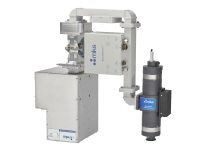Dopant Atom Diffusion
Diffusion is the movement of impurity atoms in silicon (or another semiconductor) at high temperature. Basically, diffusion can be described as a "smoothing out" of any localized high concentration of impurity atoms that is driven by the motion of the atoms in the material and by their mobility through the dominant atomic matrix (Figure 1). The impurity concentration gradient, dC/dx, is the driving force for diffusion. Diffusion can be mathematically expressed using Fick's first and second laws of diffusion. The diffusion of dopant atoms in silicon is reasonably predictable using these laws along with information on the temperature and time at temperature for a substrate. We will not discuss the quantitative relationships for diffusion here. For more details, see the excellent discussion of this topic in Wolf and Tauber's text and references therein.
Figure 1. Dopant atom diffusion in the silicon crystal lattice.
Diffusion is normally carried out in a horizontal hot-wall tube furnace that is essentially identical to the batch oxidation furnaces described in the previous section.
Thermal Processing Products
While MKS does not directly produce thermal processing equipment for the semiconductor industry, we act as an OEM supplier for producers of thermal processing products.
Related Topics
Thermal Processing
For additional insights into semiconductor topics like this, download our free MKS Instruments Handbook: Semiconductor Devices & Process Technology
Request a Handbook




 Ultra-High Velocity
Ultra-High Velocity